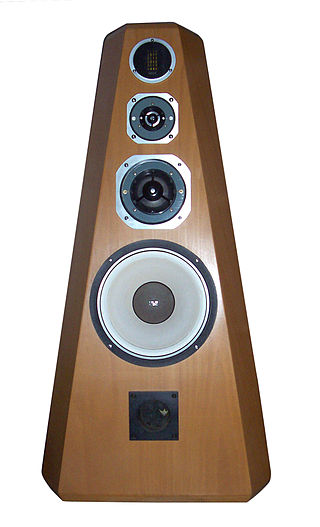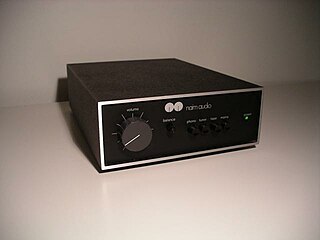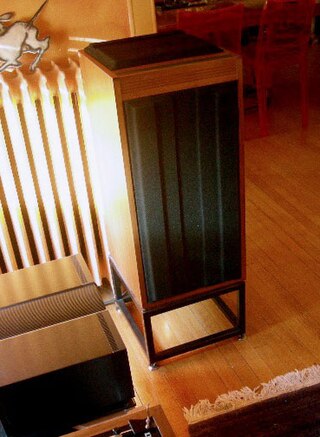
High fidelity is the high-quality reproduction of sound. It is popular with audiophiles and home audio enthusiasts. Ideally, high-fidelity equipment has inaudible noise and distortion, and a flat frequency response within the human hearing range.

Naim Audio is a British hi-fi manufacturer based in Wiltshire, United Kingdom.
Roksan is a British manufacturer of high fidelity audio products for domestic use, based in Rayleigh, Essex. It is best known for its influential and innovative design for hi-fi equipment, and in particular its Xerxes platform for playing LP records.

Julian Charles Prendergast Vereker MBE was an English self-taught designer of audio equipment, and the founder of Naim Audio Ltd. of Salisbury, Wiltshire. He was an influential figure in the manufacture and retail of British high-fidelity audio equipment in the 1970s and 1980s.
Musical Fidelity is a British producer of high-end audio equipment focusing on streaming music players, and its core product range of amplifiers of various types. Other products have included headphones, Digital-Analog Converters (DACs), CD players, Bluetooth Receivers, ‘all-in-one systems’. Founded in the United Kingdom in 1982, they are known for their unusual industrial design, Nuvistor tube use and Class-AB amplifiers.

The Linn Sondek LP12 is a transcription turntable produced by Glasgow-based Linn Products, manufacturers of hi-fi, home theatre, and multi-room audio systems. Its name is derived from the 12" vinyl LP.
Ivor Sigmund Tiefenbrun MBE is the founder and chairman of Linn Products Ltd, Glasgow-based manufacturers of high-fidelity audio equipment and home theatre equipment. He was influential in the manufacture and retail of British audio in the 1970s and 1980s, and was appointed MBE by Elizabeth II in 1992.
Luxman is a brand name of Japanese Luxman Corporation (ラックスマン株式会社) that manufactures luxury audio components. Luxman produces a variety of high-end audio products, including turntables, amplifiers, receivers, tape decks, CD players and speakers.
Technics is a Japanese brand name of Panasonic for audio equipment. Since 1965, Panasonic has produced a variety of hi-fi and audio products under the brand name, such as turntables, amplifiers, radio receivers, tape recorders, CD players, speakers, and digital pianos. Technics products were available for sale in various countries. The brand was originally conceived as a line of high-end audio equipment to compete against brands such as Nakamichi.

What Hi-Fi? is a website and magazine published by Future. It is a buying guide for consumer electronics, featuring news, reviews and features on hi-fi, home cinema, television and home audio. The website, whathifi.com, is updated daily, while the magazine is published thirteen times per year.
KEF is a British company specialising in the design and production of a range of high-end audio products, including HiFi speakers, subwoofers, architecture speakers, wireless speakers, and headphones. It was founded in Maidstone, Kent in 1961 by a BBC engineer named Raymond Cooke (1925–1995).

Pro-Ject Audio Systems is a manufacturer of audiophile equipment, founded in 1991 by Heinz Lichtenegger and located in Mistelbach, Austria. Pro-Ject Audio Systems designs the products in Austria and produces them in Europe. It produces a range of audio equipment including a family of turntables, which are often quoted as reference entry-level models. Pro-Ject Audio Systems also manufactures a range of micro hi-fi components such as Amps, CD Transports, Phono Stages, Streaming Devices, Loudspeakers and more. Today, Pro-Ject Audio Systems ship into more than 80 countries world-wide. Since 2015 Pro-Ject has released limited edition turntables in cooperation with the Beatles, The Rolling Stones, Metallica, Hans Theessink, Parov Stelar, and the Vienna Philharmonic.
Pink Triangle Products Ltd was a British audio manufacturer specialising in high end turntables.

The Roksan Xerxes transcription turntable is a record player named after the Persian king Xerxes I and produced by London-based Roksan Audio. Designed by Roksan co-founder, Touraj Moghaddam, the Xerxes is a belt-driven turntable with a solid plinth. Launched in 1985, the sound quality of the product positioned it as a strong competitor against the established industry leader, the Linn Sondek LP12. Many reviewers use the Xerxes as a reference turntable.

The Rega Planar 3, together with its successors, the P3 and RP3, is a well-known budget audiophile turntable by British hi-fi manufacturer, Rega Research available since 1977. It was a belt-drive deck that broke from convention, by employing a solid plinth in lieu of the compliantly suspended chassis or sub-chassis used in many quality turntables since the early 1960s.

The Naim NAIT is an integrated amplifier from the British hi-fi manufacturer, Naim Audio. The original NAIT is one of the most recognisable pieces of hi-fi equipment ever made. Hi-fi critic Lucio Cadeddu recognised its legendary status, referring to it as "one of the most controversial and famous integrated amps in the history of HiFi".

Naim Audio is a specialist British manufacturer of high-end audio amplifiers well known for their self described qualities of "pace, rhythm and timing".

The NAD 3020 is a stereo integrated amplifier by NAD Electronics, considered to be one of the most important components in the history of high fidelity audio. Launched in 1978, this highly affordable product delivered a good quality sound, which acquired a reputation as an audiophile amplifier of exceptional value. By 1998, the NAD 3020 had become the most well known and best-selling audio amplifier in history.

The Linn Isobarik, nicknamed "Bariks" or "Briks", is a loudspeaker designed and manufactured by Linn Products. The Isobarik is known for both its reproduction of low bass frequencies and being very demanding on amplifiers.


















